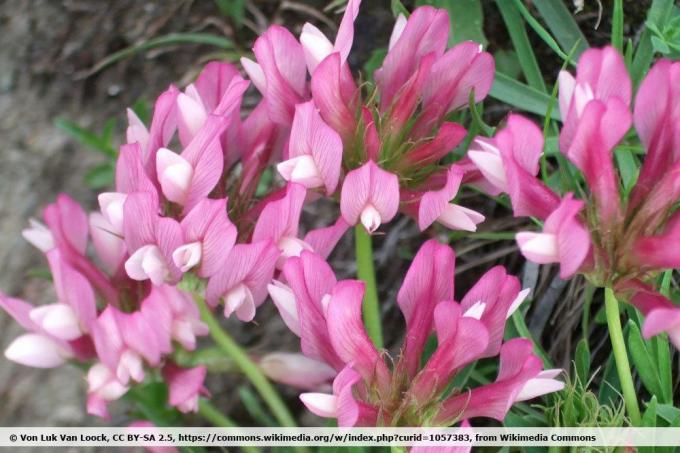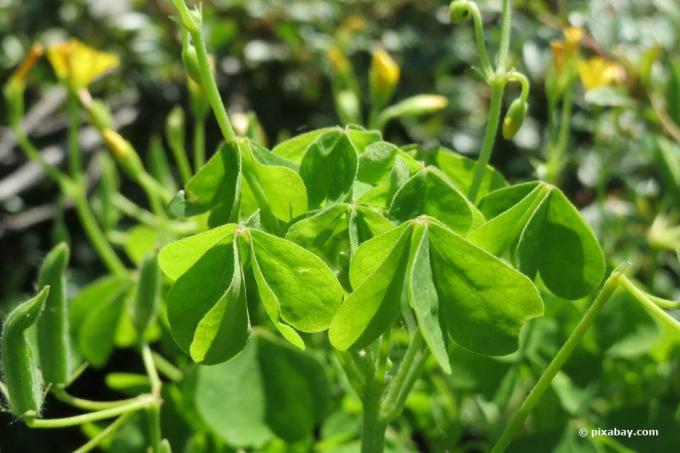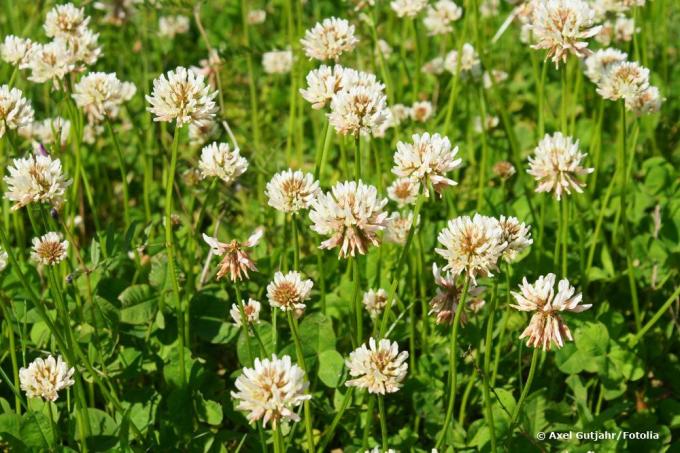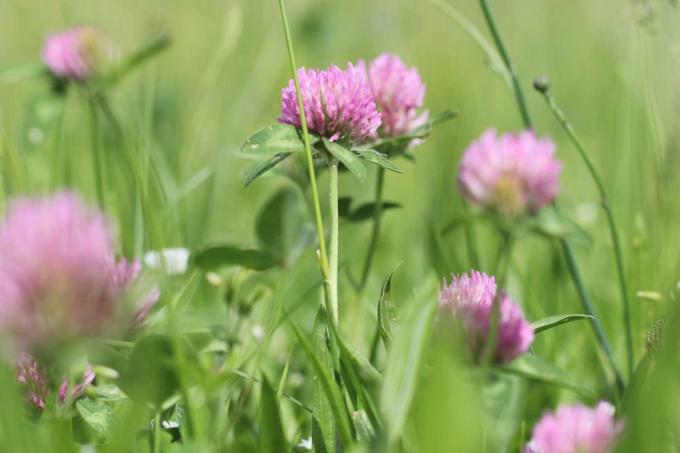
table of contents
- Clover species
- Alexandrine clover
- Alpine clover
- Arabian snail clover
- Upright wood sorrel
- Bastard snail
- Bitter clover
- Field clover
- Yellow sweet clover
- Hasenklee
- Tall sweet clover
- Horn clover
- Horned sorrel
- White sweet clover
- White clover
- Meadow clover / red clover
Colorful clover can be found everywhere in nature and on agricultural areas. About 245 different varieties belong to the Trifolium plant genus. In common usage, however, other related genera also count, such as the wood sorrel (Oxalis), the horn clover (lotus), the sweet clover (Melilotus) or the snail clover (Medicago), which are not always easy to distinguish and identify are. We will introduce you to the most common types of clover in this article.
Clover species
In the following article we present 15 different types of clover. This is how clover can be easily identified.
Alexandrine clover
This clover is originally from Egypt, which is why it is sometimes referred to as Egyptian clover. It belongs to the species of clover that can only be found in culture, as the plants are not hardy and are therefore only cultivated as an annual. The alexandrine clover (bot. Trifolium alexandrinum) is preferably grown as a catch crop in fields or as a forage plant for livestock and wild animals. It is a common substitute for red clover on agricultural land.
- Appearance: herbaceous with prostrate stems, forms race the end
- Blossom: long-stalked, terminal, spherical, light honey scent
- Flower color: yellowish white
- Flowering period: May to September
- Leaves: alternate, long-stalked, threefold pinnate, deciduous leaves obovate and finely pinnate
- Height: up to. approx. 100 centimeters
- Distribution: Middle East, North Africa, in culture worldwide since the 1950s
- Location: lawns, meadows, roadsides, agricultural areas

Alpine clover
The alpine clover (bot. T. alpinum) is one of the most beautiful species of clover that can be found in Europe. It forms strikingly large and strongly fragrant flowers. The species is not only endemic to the Alps, but also occurs in other European mountain ranges such as the Pyrenees from heights of 1700 meters and is a valuable forage plant for wild and Grazing animals.
Appearance: persistent, herbaceous, forms tap roots that reach up to one meter deep
- Blossom: up to two and a half centimeters long, few-flowered, loosely assembled flower heads
- Flower color: purple-red, strongly scented
- Flowering period: June to August
- Leaves: basal, up to five centimeters long petiole, three-part pinnate leaves with up to ten centimeters long partial leaves
- Growth height: up to 20 centimeters
- Location: low-lime meadows

Arabian snail clover
This clover is also one of the varieties that are not native to Germany. The species, often referred to in the literature as the spotted snail clover, is originally native to the Mediterranean area, but is now widespread almost all over the world. Especially in the south of Germany Medicago arabica is a rare but firmly naturalized neophyte and has been here since the end of the 19th century. Century.
- Appearance: annual, herbaceous with mostly prostrate stems, stems are hairy
- Flower: Flower cluster with one to five individual flowers
- Flower color: yellow
- Flowering period: April to June
- Leaves: alternate, composed of three broadly ovate to heart-shaped leaves
- Growth height: up to 50 centimeters
- Location: wasteland and roadsides with nutrient-rich and moderately dry clay and gravel soils
- Characteristics: brown spot on the upper side of the leaves

Upright wood sorrel
The upright wood sorrel (botanically Oxalis fontana, also Oxalis stricta) originally immigrated to Central Europe from North America and East Asia, but is now widespread. There is a red-leaved variant of the species (bot. Oxalis fontana var. 'Rufa'), which is a decorative and easy-care ornamental plant and is often planted in flower beds.
- Appearance: annual, herbaceous with initially erect and later prostrate stems, rhizome creeping underground
- Blossom: five-fold, clustered in loose clusters
- Flower color: light yellow
- Flowering period: April to October
- Leaves: light green, triple pinnate, leaves and stems are hairy
- Growth height: up to 40 centimeters
- Habitat: primarily on fresh, nutrient-rich clay soils, on fields, on roadsides, in cemeteries and in gardens

Bastard snail
This is also known as bastard alfalfa (bot. Medicago sativa ssp. varia) is a hybrid of the related varieties Medicago sativa (alfalfa) and Medicago falcata (sickle clover). The plant is now more widespread than its parent species and is very common both in culture and in its wild form. Both the ripe legumes and the taproot are edible, and they are also planted Fortification of embankments as well as for soil improvement.
- Appearance: persistent, ascending to upright, branched to shrubby
- Flower: quite small, in long-stalked clusters
- Flower color: blue to dark purple, also variants with greenish-yellow or greenish-white flowers
- Flowering period: June to August
- Leaves: alternate, threefold pinnate with elongated partial leaves
- Growth height up to 80 centimeters
- Location: primarily on dry grass and dry meadows, on roadsides, fields and bushes

Bitter clover
Also called fever clover (bot. Menyanthes trifoliata) is something very special among the clover species: It grows mainly on wet meadows and prefers moist to wet habitats. For this reason, bitter clover, which has become rare in its natural locations, is often used to plant garden pond edges.
- Appearance: persistent, loose, carpet-forming
- Blossom: racemose
- Flower color: pink, white
- Flowering period: May to June
- Leaves: oval, triple pinnate
- Growth height: up to 30 centimeters

Field clover
The field clover (bot. T. campestre) belongs to the varieties of the genus clover that are widely used as fodder and fertilizer plants. The species is preferably planted as a soil improver, but also occurs naturally in many locations. Here you will find it mainly on dry to semi-arid grassland, on fresh meadows, on embankments and along fields. Field clover is a so-called pointer species that indicates poor soil.
- Appearance: annual, herbaceous, grows upright to prostrate
- Flower: small, five-fold
- Flower color: yellow
- Flowering period: June to September
- Leaves: small, dark green, ovate, fan-shaped in three parts
- Growth height: up to 30 centimeters

Yellow sweet clover
Also called real sweet clover (bot. Melilotus officinalis) or honey clover is widespread in Europe and mainly found on the edges of stony paths and fields. It is a plant that has been used in folk medicine for centuries, but is also popular as a bee pasture in natural gardens.
- Appearance: perennial, upright and branched
- Blossom: racemose, up to ten centimeters long
- Flower color: yellow
- Flowering period: June to September
- Leaves: alternate, imparipinnate, forms stipules
- Growth height: up to 100 centimeters, sometimes up to 200 centimeters

Hasenklee
With its inflorescence that is reminiscent of pussy willow, the hazel clover (bot. T. arvense) is one of the particularly attractive species of clover. The annual clover has probably been cultivated as a medicinal plant since prehistoric times is still very numerous today on sandy to rocky and dry locations all over Europe Find.
- Appearance: annual, herbaceous
- Flower: reminiscent of pussy willow, long hairy
- Flower color: white-reddish
- Flowering period: June to July
- Leaves: alternate, threefold, lanceolate, serrated pinnate leaves
- Growth height: up to 30 centimeters

Tall sweet clover
The high sweet clover (bot. Melilotus altissimus) is easy to confuse with the common sweet clover. In order to correctly determine the species, a look at the fruit is particularly informative: In contrast to the bare fruits of the sweet clover, the fruits are covered with soft hair. The species was once widespread between Europe and Japan, but has now become rather rare. The species prefers to grow on lime and nitrogenous, salty soils.
- Appearance: biennial, herbaceous, branched, upright or arched
- Blossom: racemose
- Flower color: bright yellow
- Flowering period: July to September
- Leaves: obovate and serrated, imperforate stipules
- Growth height: up to 120 centimeters

Horn clover
In Germany the common horn clover (bot. Lotus corniculatus) widespread, and the species is often grown as a fodder plant and soil improver. The pretty plant is also often found in gardens, but can quickly become a problem due to its strong reproduction. The species is mainly determined by the eponymous, curved and narrow legumes.
- Appearance: herbaceous
- Flower: butterfly-like, arranged in umbels
- Flower color: bright yellow
- Flowering period: June to August
- Leaves: imparipinnate, obovate to elongated pinnate leaves
- Growth height: up to 40 centimeters
- Habitat: heaths, pastures, roadsides, pine forests, on the coast of the sea

Horned sorrel
In contrast to other desirable species of clover, the horned wood sorrel can be a problem in the garden. Because the horn clover (bot. Oxalis corniculata) grows mainly in lawns and is difficult to remove from them.
- Appearance: annual to perennial, short main shoot with creeping side shoots
- Flower: five-fold flower stars
- Flower color: yellow
- Flowering period: May to October
- Leaves: alternate, three-part pinnate, typical clover leaves
- Growth height: up to 20 centimeters

White sweet clover
Melilotus albus is a clover that is widespread throughout Europe and is often found together with the yellow flowering sweet clover. It mainly grows on roadsides, along railway systems, in gravel pits and on rubble sites. The species can easily be identified by its characteristic flower shape during the flowering period.
- Appearance: biennial, herbaceous
- Blossom: long, upright grapes with numerous individual flowers
- Flower color: white
- Flowering period: July to September
- Leaves: alternate, three-fingered, elongated-lanceolate, serrated leaflets
- Growth height: up to 150 centimeters

White clover
The white or creeping clover (bot. Trifolium repens) is one of the most common and probably best-known types of clover, along with the red clover. The species prefers to grow on nitrogenous soils in meadows and fields as well as along roadsides. Furthermore, this clover is not only an important fodder plant, but can also be used as a lawn substitute due to its crush resistance.
- Appearance: persistent, herbaceous, taproot up to 70 centimeters deep
- Flower: spherical with up to 80 tiny individual flowers, fragrant
- Flower color: white
- Flowering period: May to October
- Leaves: threefold with a finely serrated margin
- Growth height: up to 20 centimeters
- Characteristics: typical leaf markings with narrow, arched and white-gray stripes on a dark green background

Meadow clover / red clover
A very colorful clover is the red clover (bot. Trifolium pratense), which is a cultivated form of the meadow clover that is widespread in Europe. The species grows mainly in fat meadows, in sparse forests as well as in fields and prefers fresh, nutrient-rich loam and clay soils.
- Appearance: persistent, herbaceous, upright
- Flower: spherical, multi-flowered inflorescences
- Flower color: reddish purple
- Flowering period: June to September
- Leaves: alternate, tripartite pinnate, slightly hairy
- Growth height: up to 80 centimeters

